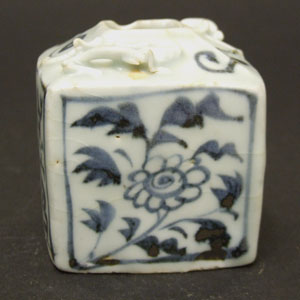
YUAN 1279 – 1368 Early Blue and White Porcelain
A Yuan Blue and White Porcelain Waterpot, Jingdezhen Kilns c.1320 – 1368. This Early Chinese Blue and White Porcelain Waterpot is of Square Form with a Square Aperture to the Top with Two Qilong Dragons Hand-Modelled in Relief. The Side Painted with Flowers within Square Panels.
SOLD
- Condition
- Good, a feint crack rim c.10 mm, minute chips to the tops of the Qilong dragons legs c.1 mm. Feint glaze crack visible to part of the lutting-line.
- Size
- Height : 6.6 cm (2 2/3 inches).
- Provenance
- N/A
- Stock number
- 22471
- References
- For a Yuan blue and white square waterpot of this type from the Eric E. Geiling Collection, Exhibited at The Cologne Museum of Oriental Art, see : Chinesische Keramik Auf Den Philippinen (Die Sammlung Eric E. Geiling, Bearbeitet Von Ulrich Wiesner, Museum Fur Ostasiatische Kunst) page 166, plate 140. Another similar Yuan blue and white waterpot see Exhibition of Chinese Blue and White Porcelain and Related Underglaze Red (Introduction by Sir John Addis, The Oriental Ceramic Society of Hong Kong, 1975) page61, plate 1. For a Yuan blue and white waterpot of this type but rather more refined painting see : Fine Chinese Ceramics and Works of Art, Sotheby`s New York, September 21, 2006, lot 299. Another Yuan blue and white waterpot of this type see : Chinese Blue and White Ceramics (S.T. Yeo & Jean Martin, South East Asian Ceramic Society, 1978) page 98, plate 4. For further Yuan Blue and white porcelain waterpots of this type see : Chinese and Vietnamese Blue and White Wares Found In The Philippines (Gotuaco, Tan and Diem, Bookmark, 1997) pages 72 and 73.
Information
Chinese Blue and White Porcelain :
The origins of Chinese blue and white porcelain start, not in China, but in the Middle East, it was originally developed in Mesopotamia. The source of the first cobalt blue pigment used in China was also not Chinese and the dynastic power in charge of China at the time, the Mongol`s of the Yuan dynasty, was a foreign power. Yet blue and white porcelain will for ever be linked to China because of the ceramics produced at Jingdezhen. Blue cobalt pigment was sometime used in China during the Tang dynasty (618-906) nearly always as an additional colour in Sancai pottery but the first use on porcelain was at the start of the 14th century. It was used in a very different way, unlike the Tang use where splashes of cobalt were used to add colour, the Yuan potters used it to carefully painted designs. This would have been very difficult to achieve using the the high flux lead glazes of Tang pottery.
The body developed for blue and white porcelain at Jingdezhen was almost from the very beginning of exceptionally high quality as was the glaze, which was midway between a Qingbai and Shufu glaze. This true lime-alkaline glaze was less fluid than Qingbai glazes so the blue was less likely to run and less opaque than Shufu glaze so the painting appeared more brilliant. The most of the imported cobalt blue pigment used for Chinese blue and white porcelain of the 14th and 15th centuries came from Kashan in Persia. For further reading about early Chinese blue and white porcelain see : Chinese Glazes, Their Origins, Chemistry and Recreation (Nigel Wood, A & C Black, London, 1999).
Yuan Dynasty :
Temüjin, later to be more prominently known as Genghis Khan, was officially the first in the line of Yuan Dynasty emperors. He was the son of Yesügei, the tribal chief of the Kiyad — a tribe in fragmented Mongolia under nominal control of the Jin Dynasty at the time. His father was killed in his early life by a rival tribe, the heir. This led to bitterness on the part of Senggum, Wang`s former heir, who planned to assassinate Temüjin. Temüjin learned of Senggum`s intentions however, and a large civil war broke out among the Mongols. Eventually Temüjin defeated Senggum and succeeded to the title of Wang Khan. Temüjin created a written code of laws for the Mongols called Yassa, and he demanded it to be followed very strictly. Temüjin followed with attacks on other neighboring tribes, which further increased his power. By combining diplomacy, organization, military ability, and brutality, Temüjin finally managed to unite the tribes into the single nation, a monumental feat for the Mongols, who had a long history of internecine dispute. In 1206 Temüjin successfully united the formerly fragmented tribes of what is now Mongolia. At a Khurultai (a council of Mongol chiefs), he was named the "Genghis Khan", or the "Universal Ruler". The birth of Mongolia marked the start of what would become the largest continuous empire in history, ruling large parts of Asia, the Middle East and parts of Europe, over the following two centuries. While his empire extended in all directions, Genghis Khan’s main interest was always with the rest of China, specifically Western Xia, Jin Dynasty and southern Song Dynasty.